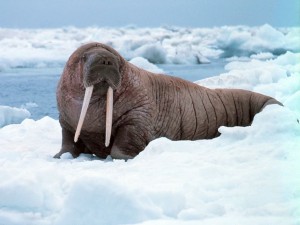16 December 2014
Researchers keep an eye on walrus ice preferences
Posted by kwheeling
By Kerry Klein
To walruses, ice means life. It’s their home base, their mating ground, and their transportation. As climate change threatens the extent of ocean ice, a new study takes a first step at determining how changing ice conditions are influencing walrus dynamics.
During the winter, Pacific walruses gather on ice in the Bering Sea to mate and give birth. For the summer, moms and their young migrate north through the Bering Strait to ice in the Chukchi Sea, some hitching rides on ice drifts to get there. Because these seafloor-foragers aren’t deep divers, an ideal home typically comprises an ice shelf overlying relatively shallow water.
But studies show that ice conditions in the Bering Sea are changing. Even though the maximum annual ice cover has remained relatively steady since the 1970s, seasonal ice cover is highly variable.
“The summer sea ice is disappearing at an alarming rate,” said Alexander Sacco, a master’s student at the University of Alaska, Fairbanks, at a poster session Monday at the American Geophysical Union’s Fall Meeting in San Francisco.
Each summer, ice shelves are retreating further northward, according to Sacco, meaning that walruses that migrate to ice shelves might find themselves in deeper water, further from the shallow seafloor crustaceans and mollusks they need for sustenance.
Sacco and his colleagues set out to quantify the amount of fractured ice in the Bering Sea, and to observe whether walruses were beginning to prefer it over solid ice.
First, the researchers developed an algorithm to measure sea ice cover using satellite imagery. For three years from 2006-2008, they categorized the sea surface as either fractured ice or homogeneous—all ice or open water—based on images produced by aerial radar. Using observations of ice conditions taken by a U.S. Coast Guard icebreaker, they honed their algorithm and recorded where walruses preferred to settle—either on fractured ice or on a homogeneous surface.
Preliminary results are inconsistent but suggest the relationship should continue to be monitored. In 2006 and 2008, walrus populations seemed to distribute themselves evenly across the Bering Sea: If roughly two-thirds of the sea was fractured ice, roughly two-thirds of the walruses were resting there. But in 2007, when fractured ice made up half the landscape, 85 percent of observed walruses were resting on this fractured ice.
The findings surprised the research team. “I would have expected more of 2007’s results,” said Sacco. He suspects year-to-year differences could derive from annual climate variations. Or, perhaps, they indicate that the researchers need to be more sensitive to small-scale vs. population-wide trends. “At a local scale, they may just haul onto whatever’s nearby,” he said, while the general population may be shifting in subtle ways.
Kerry Klein is a science communication graduate student at UC Santa Cruz.



 GeoSpace is a blog on Earth and space science, managed by AGU’s Public Information staff. The blog features posts by AGU writers and guest contributors on all sorts of relevant science topics, but with a focus on new research and geo and space sciences-related stories that are currently in the news.
GeoSpace is a blog on Earth and space science, managed by AGU’s Public Information staff. The blog features posts by AGU writers and guest contributors on all sorts of relevant science topics, but with a focus on new research and geo and space sciences-related stories that are currently in the news.